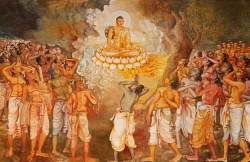Suffering and the Problem of Evil
by Julia Hardy
The first sermon that the Buddha preached after his enlightenment concerned the Four Noble Truths. This is the most well known of Buddhist doctrines in the west, and there are some fairly standard English translations ("Life is suffering. The cause of suffering is desire," and so forth), but the standard translations are somewhat misleading. First, these are not truths that are noble, but truths that have been realized by the (spiritually) noble. They might more accurately be called four realities of life known to those who are spiritually aware. These four realities are: the truth of suffering, the truth of arising, the truth of cessation, and the truth of the path.
Suffering: The word often translated as suffering has no English equivalent. The meaning of the phrase is not that "life is miserable," as the English translation might seem to indicate, but that some pain is inevitable in life. Birth is painful, sickness is painful, aging is painful, death is painful. It is painful to experience unhappiness and displeasure; it is painful to want something and not be able to have it; it is painful to have something and lose it; it is painful when a pleasurable experience ends.
What the Buddha had been seeking when he became enlightened was a way out of samsara, the endless cycle of death and rebirth. The Hindu texts, the Upanishads, which were written at around the same time, had argued that the way out of the endless cycle of death and rebirth was to realize that one's individual self or soul (atman) is a part of the world soul (Brahman).
Some scholars argue that the Buddha's solution to end this cycle was to realize that there is no self, no atman. If there is no self, there is nothing to reincarnate, nothing to endure this endless cycle. Others scholars argue that Buddha refused to answer questions about the self, and that to deny the existence of the self is just as much of an obstacle as is the self.
According to textual accounts of his first sermon, written long after his death, what the Buddha said was that the forms of suffering he listed (birth, sickness, aging, loss, etc.) are examples of "the five aggregates subject to clinging." These five aggregates, or skandhas, are what makes up the self: form, sensation, perception, mental formations, and consciousness. Each of these constituents is constantly changing, constantly in flux; therefore the "self" is also constantly changing. Thus while there may be an experience of selfhood, there is no permanent, unchanging self.
Arising: Humans tend to long for what they do not have, or to wish for their lives to be different than they are; they often fail to fully appreciate what they do have. This longing (craving, desire) gives rise to, or causes, a new cycle of life and death.
The Four Noble Truths are often understood as a series of propositions, or as a prescription for approaching disease: symptom/cause/elimination of cause/remedy. In this formulation, cause, or arising, is the pivotal moment. Buddhist scholar Donald Lopez says, "If it is possible to identify a particular contribution of the Buddha to the philosophies of his day, it would be the thoroughgoing emphasis on causation as an inexorable force whose devastating effects can be escaped by understanding its operation. That is, everything is an effect of a cause. If the cause can be identified and destroyed, the effect is also destroyed."
Cessation: It is possible to stop this cycle.
Path: The path to the end of suffering is the Noble Eightfold Path (that is, the eightfold path for the spiritually aware): right view, right intention, right speech, right action, right livelihood, right effort, right mindfulness, right concentration.
This remedy of the Eightfold Path may seem like a moral answer to a philosophical problem, and to some extent, it is. Ashoka, when spreading his edicts about the teachings of Buddhism, focused on moral guidelines rather than complex philosophical ideas. On another level, this list is a response to the audience, to which it is addressed, the men with whom Buddha had practiced extreme asceticism before deciding that it was not the right path for him. According to the texts, the Buddha began his sermon by saying that one should follow a middle path between asceticism and hedonism, and then he listed the elements of the Eightfold Path, repeating them again shortly afterward when presenting the four truths. Thus, one meaning of the Eightfold Path is that extreme approaches to seeking enlightenment are not necessary.
In Buddhism, while life may be full of suffering, it is not evil, nor are there evil entities in the world tempting people to sin and self-destruction. This is not to say that there are no demonic forces in the Buddhist world. There are demons that can cause disease or other misfortunes, and demons to punish wrongdoers in the Buddhist hells, but an angry deceased relative can be equally dangerous.
Often Buddhists enlist demons into the service of the good. For example, before beginning to make a sand mandala, Tibetan monks will capture demons and install them at the four corners of the mandala to protect it. In Japan one can obtain a "traffic demon" amulet as protection from automobile accidents. Buddhists have long been regarded as specialists who can be counted on to defeat or convert demons, which they do through spells, rituals, or dialogue. They may also transfer merit or otherwise meet the spiritual need of the demon, and thus convert it.
If there is "evil" in Buddhism, it is the greed, anger, and delusion that give rise to samsara. Human nature is not evil, per se, but it can give rise to suffering. The goal of the Buddha's dharma is not to eliminate all suffering or to create a perfect life or world, but to learn how best to deal with the suffering that is a normal part of human life.

